Do you have a question about the Elektro-Automatik PS 9080-50 and is the answer not in the manual?
| Output Voltage | 0-80 V |
|---|---|
| Output Current | 0-50 A |
| Power Rating | 4000 W |
| Number of Outputs | 1 |
| Type | Programmable DC Power Supply |
| Output Power | 4000 W |
| Cooling | Temperature-controlled fan |
| Interface | USB, RS232, Analog |
| Input Frequency | 50/60 Hz |
| Protection Features | OVP, OCP, OTP |
Information about the document's purpose, retention, and copyright.
Explains symbols used for warning and safety notices in the manual.
Details the manufacturer's warranty for functional competence and performance.
Outlines manufacturer's liability limitations for product usage and modifications.
Guidelines for safely transporting and storing the device.
Instructions for unpacking and visually inspecting the device for damage.
Procedures and safety precautions for installing the device.
Information on proper disposal of the equipment according to regulations.
Explanation of the product identification label and its components.
Defines the proper and intended applications for the power supply.
Crucial safety information and guidelines for operating the device.
Detailed safety notices, including hazards and precautions.
Details user responsibilities regarding safety and operation.
Outlines operator responsibilities for safe usage and maintenance.
Specifies qualifications and requirements for operating personnel.
Describes various alarm signals, their meanings, and effects.
Provides detailed technical specifications of the device.
Specifies environmental and operational conditions for safe use.
Lists general technical specifications like display and controls.
Detailed technical data tables for different models.
Visual representation of the device's front and rear panels.
Describes the physical construction and operational principles.
Overview of the power supply's design and features.
Illustrates the internal components and their interconnections.
Lists items included in the package.
Detailed explanation of the human-machine interface and its functions.
Information on connecting multiple units for parallel operation.
Details on using the USB port for communication and updates.
Information on connecting and using the Ethernet port for control.
Describes the analog interface for remote control and monitoring.
Explains the remote sensing feature for accurate voltage control.
Crucial safety steps to follow before installing and using the device.
Steps to prepare for device installation and connection.
Procedures for commissioning after updates or prolonged non-use.
Introduction to the calibration and readjustment function.
Tools and conditions required for successful calibration.
Step-by-step guide for performing calibration.
General information about repairs and returning the device.
How to contact technical support for assistance.
States the validity of the manual for specific equipment models.
Explains symbols used for warning and safety notices in the manual.
Details the manufacturer's warranty for functional competence and performance.
Outlines manufacturer's liability limitations for product usage and modifications.
Detailed safety notices, including hazards and precautions.
Details user responsibilities regarding safety and operation.
Specifies environmental and operational conditions for safe use.
Lists general technical specifications like display and controls.
General important notes for operation, including safety.
Safety precautions related to personal protection during operation.
General operational guidelines and considerations.
Explains the different operating modes like constant voltage and current.
Details the constant voltage (CV) operating mode.
Explains constant current (CC) and current limiting modes.
Describes the Power Fail (PF) alarm and its causes.
Explains the Overtemperature (OT) alarm and its causes.
Details the Overvoltage (OVP) alarm and its implications.
Describes the Overcurrent (OCP) alarm and its purpose.
Explains the Overpower (OPP) alarm and its protective function.
Procedures for switching the device on.
Procedures for switching the device off.
Guide to configuring device settings via the setup menu.
Overview of remote control possibilities via different interfaces.
Defining manual vs. remote control locations.
Using USB and Ethernet for remote control.
Choosing between USB and Ethernet interfaces.
General considerations for digital interface setup.
Details on programming via digital interfaces.
Overview of analog interface capabilities.
Technical details on analog interface resolution and sample rate.
How to acknowledge alarms via analog interface.
Specific example of using REM-SB to control DC output.
Defines terms related to device alarms and monitoring.
Procedures for handling device alarms.
Steps to lock the control panel to prevent accidental changes.
Steps to unlock the control panel after it has been locked.
Steps to save current settings into a user profile.
Steps to load a previously saved user profile.
Connecting multiple units for parallel operation using Share Bus.
Guidelines for wiring DC outputs in parallel operation.
Instructions for wiring the Share Bus connection.
Steps to configure units for Share Bus master/slave operation.
Introduction to two quadrants operation.
How to connect devices for two quadrants operation.
Guidelines for cleaning and maintaining the device.
Procedures for diagnosing and reporting faults.
Instructions for replacing the main fuse.
How to perform firmware updates.
Introduction to the calibration and readjustment function.
Tools and conditions required for successful calibration.
Step-by-step guide for performing calibration.
General information about repairs and returning the device.
How to contact technical support for assistance.
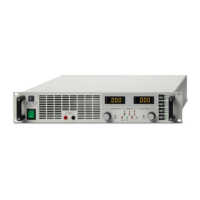
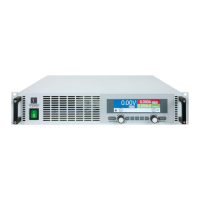
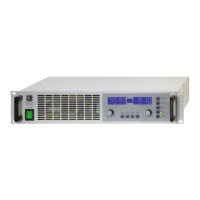
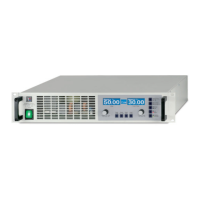
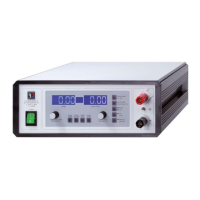
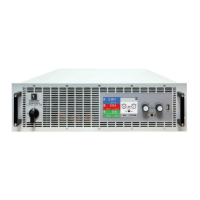
